

Earth System Science. Earth System Science In the phrase "Earth system science (ESS)," the key term is "system.
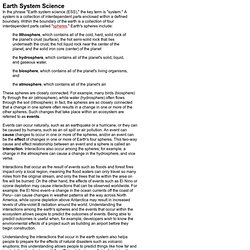
" A system is a collection of interdependent parts enclosed within a defined boundary. Within the boundary of the earth is a collection of four interdependent parts called "spheres. " Earth's spheres include: the lithosphere, which contains all of the cold, hard, solid rock of the planet's crust (surface), the hot semi-solid rock that lies underneath the crust, the hot liquid rock near the center of the planet, and the solid iron core (center) of the planet the hydrosphere, which contains all of the planet's solid, liquid, and gaseous water, the biosphere, which contains all of the planet's living organisms, and the atmosphere, which contains all of the planet's air. These spheres are closely connected. Planetary Whole System Design Science: A Contribution to WorldShift 2012 - by José Argüelles/Valum Votan.
Planetary Whole System Design Science: A Contribution to WorldShift 2012 www.lawoftime.org, www.noosphereforum.org Dr.
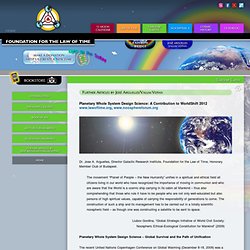
Jose A. Arguelles, Director Galactic Research Institute, Foundation for the Law of Time, Honorary Member Club of Budapest. The movement “Planet of People – the New Humanity” unifies in a spiritual and ethical field all citizens living in our world who have recognized the importance of moving in communion and who are aware that the World is a cosmic ship carrying in its cabin all Mankind – thus also comprehending that those who rule it have to be people who are not only well-educated but also persons of high spiritual values, capable of carrying the responsibility of generations to come. The construction of such a ship and its management has to be carried out in a totally scientific noospheric field – as though one was constructing a satellite to be sent to space.
Earth Dashboard. Homepage. ICES Foundation. JOURNAL OF WORLD-SYSTEMS RESEARCH. Archived ICESS Home Page. Welcome — DIVERSITAS. Earth system science. Earth system science seeks to integrate various fields of academic study to understand the Earth as a system.
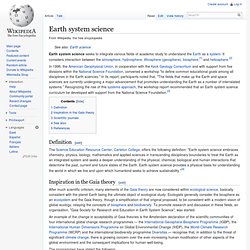
It considers interaction between the atmosphere, hydrosphere, lithosphere (geosphere), biosphere,[1] and heliosphere.[2] In 1996, the American Geophysical Union, in cooperation with the Keck Geology Consortium and with support from five divisions within the National Science Foundation, convened a workshop "to define common educational goals among all disciplines in the Earth sciences. " World-systems theory. A world map of countries by trading status, late 20th century, using the world system differentiation into core countries (blue), semi-periphery countries (purple) and periphery countries (red).
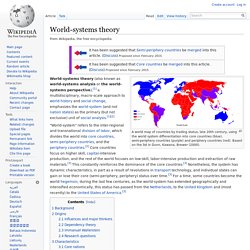
Based on the list in Dunn, Kawana, Brewer (2000). World-systems theory (also known as world-systems analysis or the world-systems perspective),[1] a multidisciplinary, macro-scale approach to world history and social change, emphasizes the world-system (and not nation states) as the primary (but not exclusive) unit of social analysis.[1][2] Background[edit] Immanuel Wallerstein has developed the best-known version of world-systems analysis, beginning in the 1970s.[4][5] Wallerstein traces the rise of the capitalist world-economy from the "long" sixteenth century (c. 1450-1640).
Many other scholars have contributed significant work in this "knowledge movement".[2] Origins[edit] Influences and major thinkers[edit] World-systems theory was aiming to replace modernization theory. Dependency theory[edit] Portal:Earth sciences. The Earth Sciences Portal The major disciplines of Earth sciences use physics, mathematics, and chemistry to build a quantitative understanding of the principal areas or spheres of the Earth system.
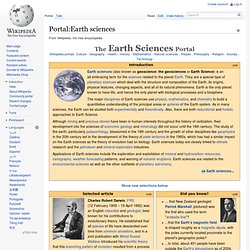
As in many sciences, the Earth can be studied both experimentally and theoretically. Also, there are both reductionist and holistic approaches to Earth Science. ESSE 21 - Home. How the Living Earth Simulator Will Work" The kings of old knew the weight of their decisions.
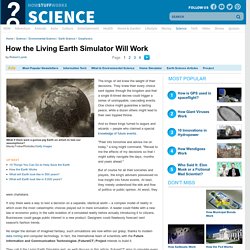
They knew their every choice sent ripples through the kingdom and that a single ill-timed decree could trigger a series of unstoppable, cascading events. One choice might guarantee a lasting peace, while a dozen others might lead to their own toppled throne. Living Earth Simulator Project. The living Earth simulator is a proposed massive computer simulation system intended to simulate the interactions of all aspects of life, human economic activity, climate, and other physical processes on the planet Earth as part of the FuturICT project,[1] in response to the European FP7 "Future and Emerging Technologies Flagship" initiative.[2] There are over 300 international teams seeking ~€1 billion for the 10-year FuturICT project.[3] The Earth Simulator was apparently not selected since the two winners have been announced as of March 2013.
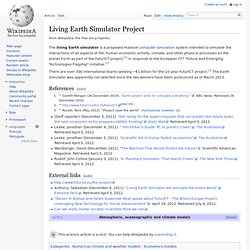
References[edit] (Staff reporter) (December 5, 2011). Start - IHDP. International Human Dimensions Programme. The International Human Dimensions Programme on Global Environmental Change (IHDP) is a research programme that studies the human and societal aspects of the phenomenon of global change.

IHDP aims to frame, develop and integrate social science research on global change, and promote the application of its key findings. It strives to develop research approaches that put societies at the center of the debate, looking at current global environmental problems as social and societal challenges.[1] IHDP’s work brings together groups of multi-disciplinary and multi-national researchers to work on long-term collaborative science.
It’s major role within the scientific field is providing leadership in the selection and development of themes for focused research and in stimulating scientific communities to coordinate their efforts on these themes within the framework of its projects. History[edit] Secretariat[edit] Earth System Science Partnership (ESSP)[edit] Projects[edit] References[edit] Essp.org. Home. Antonio Busalacchi Professor and Director From the polar ice caps to the deserts of China, from the skies over Oklahoma to the Atlantic Ocean near Northeast Brazil, ESSIC scientists are busy examining the Earth's Systems through the various lenses of their particular specialties. Cutting across the traditional disciplinary boundaries of meteorology, oceanography, geology and geography, ESSIC seeks to better understand how the land, the oceans and the atmosphere react with, and influence, one another.
Journal of Earth System Science. Contributing to a fundamental scientific understanding of the Earth as a coupled system, through research and teaching. Rainbow Charts. Earth System Science. Latest news: International Council for Science — ICSU. GEO BON - GEO Biodiversity Observation Network. Adequacy of Biodiversity Observation Systems In response to a decision taken last November at the Nagoya conference of the Convention on Biological Diversity, GEO BON has produced and submitted to the CBD a report entitled "Adequacy of Biodiversity Observation Systems to support the CBD 2020 Targets".
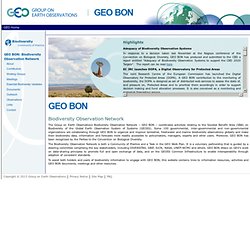
The report can be read here. EC JRC launches DOPA, a Digital Observatory for Protected Areas. GEO - Group on Earth Observations. Global geospatial community to convene in Geneva on May 5-9 Geospatial Media and Communications, in partnership with the Group on Earth Observations (GEO) and SwissTopo, will host the Geospatial World Forum on 5-9 May 2014 in Geneva.
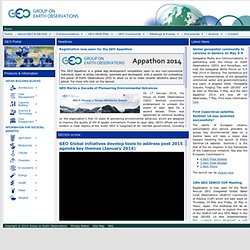
The conference will convene representatives of the geospatial commercial sector and government/policy end users. A program titled, "Geospatial Industry Forging Ties with GEOSS" will be held on Monday, 5 May, and the GEO Appathon 2014 will kick off on Wednesday, 7 May. Find more information here. First Copernicus satellite, Sentinel 1A was launched successfully! The ability of European citizens, policymakers and service providers to access key environmental data on a routine basis will take a major step forward following the launch of ESA's Sentinel-1A satellite.
The launch can be viewed here 10th GEO IGWCO COP Meeting Global Agriculture Ministers Recognize Value of GEOGLAM GEO Issues GEOSS AIP Call for Participation GEO Congratulates JAXA-NASA on GPM Launch. "Earth System Science" IGBP - IGBP.